G.O.D. | Generative Ominous Dataset
PT | EN
As representações artísticas de Deus na tradição cristã ocidental estão principalmente conectadas à visão e, como as representações figurativas se referem essencialmente a entidades corpóreas, a natureza triádica de Deus – Pai, Filho e Espírito Santo – sempre desafiou essa abordagem.
Assim, é frequente existirem representações estilizadas dessa natureza, encapsulando um olho (o olho de Deus, que tudo vê).


G.O.D. | Generative Ominous Dataset – é uma obra de arte generativa, que instancia a interpretação convergente de uma “tríade” de conceitos-chave:
1 – DATA = GOD – Os progressos recentes realizados sobre Redes Generativas Adversariais e Processamento de Linguagem Natural tornaram acessíveis ao público, e com uma popularidade sem precedentes, sistemas de Inteligência Artificial (IA) capazes de gerar texto complexo e assertivo, bem como imagens de elevada qualidade e variedade, de forma interativa, baseada em pedidos descritivos escritos. No entanto, os vastos – e sobretudo não autorizados – datasets usados para treinar as IAs são a chave para seu sucesso. Com efeito, a cada minutos são recolhidas e processadas vasta quantidades de informação pessoal, e assim, o “olho que tudo vê” aparece como uma metáfora relevante para os “DADOS enquanto “DEUS”.
2 – OMINOUS DATASET – O conjunto de dados (dataset) usado por G.O.D. consiste em imagens obtidas a partir da Internet, num processo semelhante ao dos sistemas de IA: desconsiderando qualquer possível violação de direitos autorais, numa clássica – e muito questionável – afirmação de que o “fim justifica os meios”. Assim, a designação de “OMINOUS DATASET” (conjunto de dados sinistro) vai ao encontro das suas origens, uma vez que a obra pretende também incentivar o debate. Reforçando o comportamento “sinistro” que subjaz a estes processos de recolha de dados, as imagens usadas por G.O.D. retratam situações de violência, guerra, destruição, conflito, assédio, crueldade, protestos de rua, repressão violenta e desastres naturais. No entanto, ao contrário dos datasets usados pelos sistemas de IA, G.O.D. alterou profundamente as imagens originais, tornando-as irreconhecíveis, antes de serem usadas para construir a radiância de G.O.D.
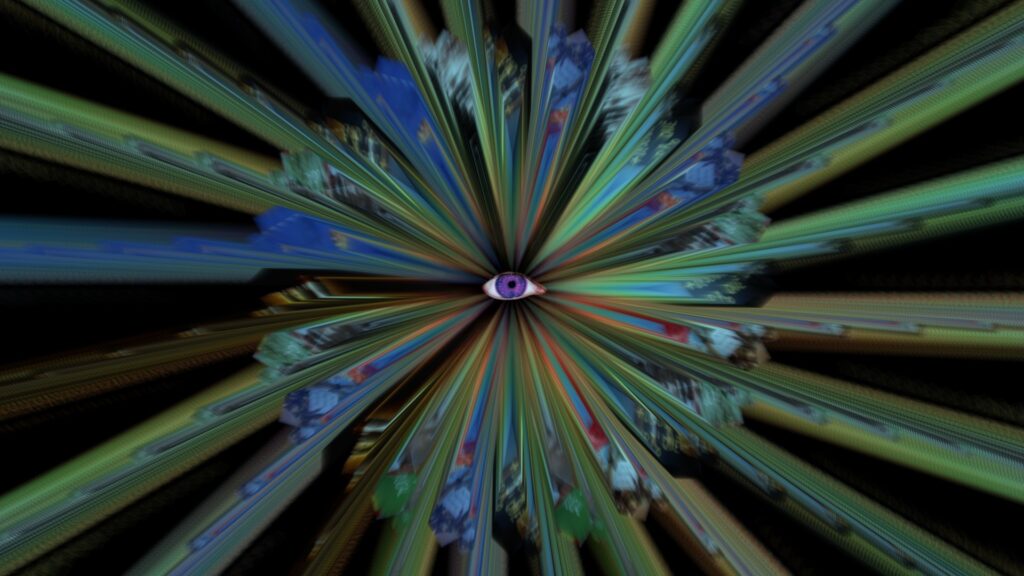
3 – EPIFANIA GENERATIVA – G.O.D. oferece resplendores infinitos e radiantes de iluminação generativa, irrepetíveis, como surtos de epifanias hipnóticas, combinando simetria e caos nas revelações estéticas. Assim, a apreciação cognitiva do público é constantemente estimulada – e simultaneamente relaxada. Enquanto instalação generativa, em run time, G.O.D. consiste num fluxo contínuo de padrões únicos, o que justifica a descrição da experiência resultante como uma sucessão infinita de epifanias, quase “um arrebatamento estético”, uma inundação sensorial do divino.
G.O.D is a generative non-interactive – yet infinite – cinematic and hypnotic installation, triggered by a call for participation, under the general title of “Vision of God” *.
Artistic depictions of God in the Western Christian tradition are mostly connected to vision and because figurative depictions essentially refer to corporeal entities, the triadic nature of God – Father, Son and Holy Ghost – has challenged this approach. Hence some artists chose to depict God’s hand or God’s all-seeing eye, such as the one present in St. James Catholic Church, in Louisville, KY, USA.
/cloudfront-us-east-1.images.arcpublishing.com/gray/CHTKDXKN4ZCVHPPFZ5DHVVXAFE.jpg)
Gustave Doré’s Rosa Celeste (~1892), where Dante and Beatrice gaze upon the highest Heaven, The Empyrean, embodies one common element in the representations of God: the all encompassing radiance, also present in the above image.

Finally, Ernst Fuchs’ “Apocalypse Chapel” (1990-2000), with its vibrant palette and profuse decoration, provided yet more (chromatic) inspiration for G.O.D..
![]()
G.O.D. | Generative Ominous Dataset – is the author’s convergent interpretation and rendition of a (carefully curated and rather appropriate) “triad” of key concepts:
1 – DATA as GOD – Recent advances in Generative Adversarial Networks and Natural Language Processing brought to the public eye, with unprecedented popularity, Artificial Intelligence systems, capable of generating both text and images from interactive user prompts, thus (apparently) enabling non-experts to deliver artistic quality images and elaborate texts, which would otherwise be impossible for non-artists or non-writers/scholars. However, the vast – and mostly unauthorised – datasets used to train the AIs are the key to their success. Behind the hype surrounding such systems, Big Data is feverishly collecting ever-expanding amounts of user information, both for consumerist and control purposes alike. Thus, the “All Seeing Eye” appears as a relevant metaphor for “DATA as GOD”.

2 – OMINOUS DATASET – The dataset used by G.O.D. consists of images retrieved from the Internet in a similar way to modern AI systems: disregarding any potential copyright infringements, in a classic – yet questionable – claim that the end justifies the means. Hence, the designation of an “ominous dataset” is in line with its origins, as the installation’s purpose is also to spark the debate. But this author decided to take it one step further, and so all the images used by G.O.D. depict situations of violence, war, destruction, conflict, harassment, cruelty, street protests, violent repression, and natural disasters, all ominous in nature. However, unlike the datasets used by AI systems, G.O.D. profoundly altered the source images and rendered them unrecognisable, before proceeding to use them to depict God’s (and G.O.D.’s) Radiance and Revelations.
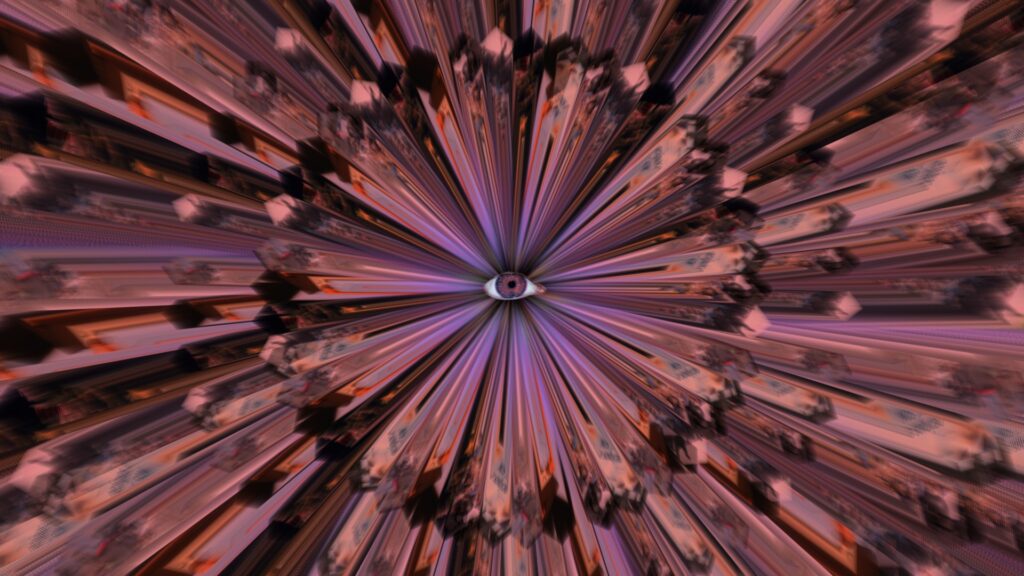
3 – GENERATIVE EPIPHANY – G.O.D. delivers infinite, radiant bursts of generative enlightenment, without any repetitions, like surges of hypnotic epiphanies, combining symmetry and chaos in the aesthetic revelations. Thus the public’s cognitive appreciation is constantly stimulated – yet relaxed, at the same time. As a generative installation, during run-time G.O.D delivers an infinite stream of never repeating patterns, therefore one could define the G.O.D. experience as an infinite succession of epiphanies, almost “an aesthetic rapture”, a sensory flood by the divine.

GICLÉE FINE-ART PRINTS
A very limited set of square, 50cm x 50cm, giclée fine-art prints was also specially produced, each one completely unique. Some examples below:

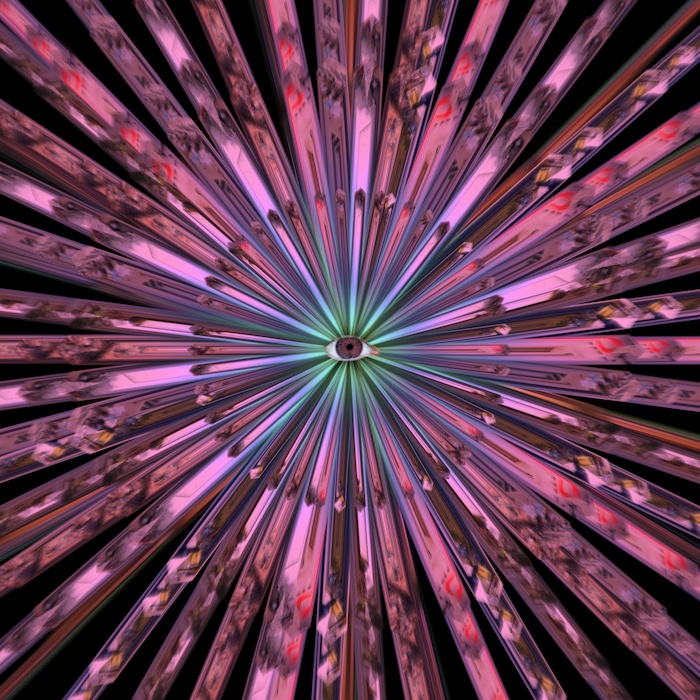

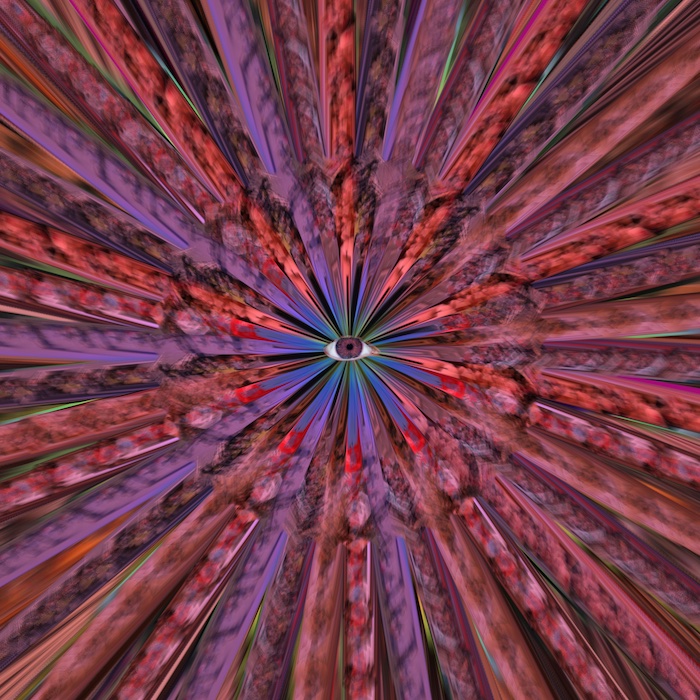
These framed prints can be viewed (and purchased) at Bull & Stein Gallery, Porto.
For more informations, please use the contact form.
* Some paragraphs from the original call are worth highlighting, as they provided some inspiration for the artwork, as answers to the questions:
“For something to be seen, there are characteristics that must be present: at least extension, to be circumscribed, and to reflect light. If God is infinite, uncircumscribed, indefinable, pure spirit, how can He be seen and depicted?”
Only by affecting the spirit through a(n endless) vision.
“For how can the corporal eyes see something infinite and unlimited?”
By providing an infinite stream of contemplation.
For exhibition purposes, a pre-rendered version is available to be displayed as a video/projection.
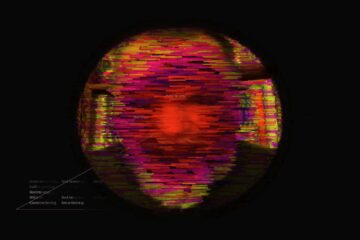


1 comentário
G.O.D.L.E.S.S | G༙྇A༙྇Z༙྇A༙྇ OMINOUS DATASET: LAWLESS EVIL SYSTEMATIC SLAUGHTER – Pedro Alves da Veiga · 11/01/2024 às 18:33
[…] G.O.D. | Generative Ominous Dataset […]
Os comentários estão fechados.